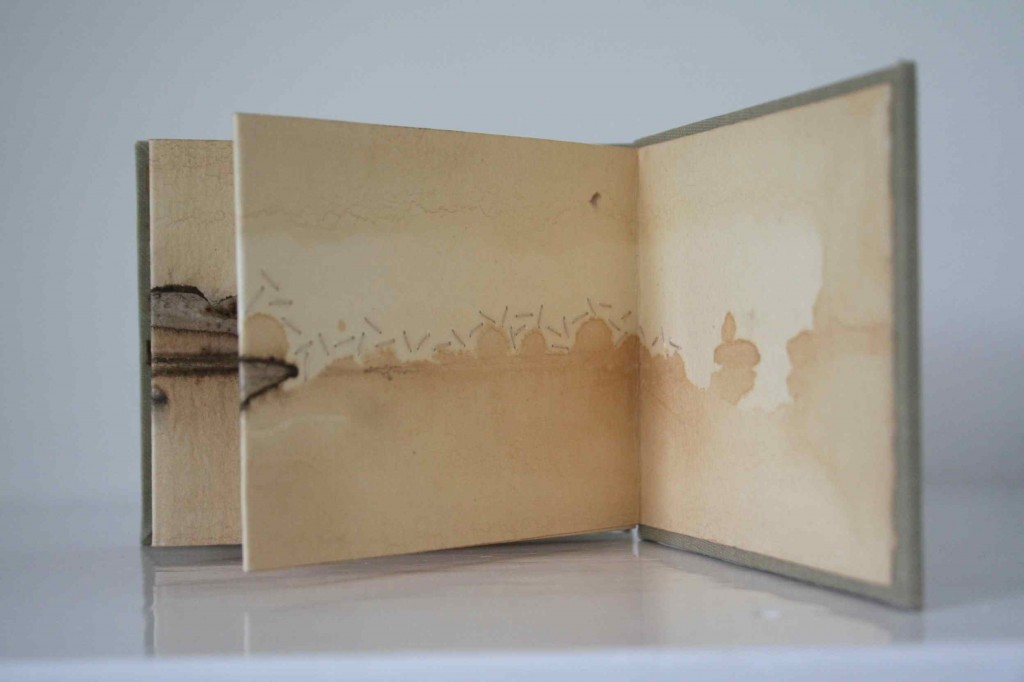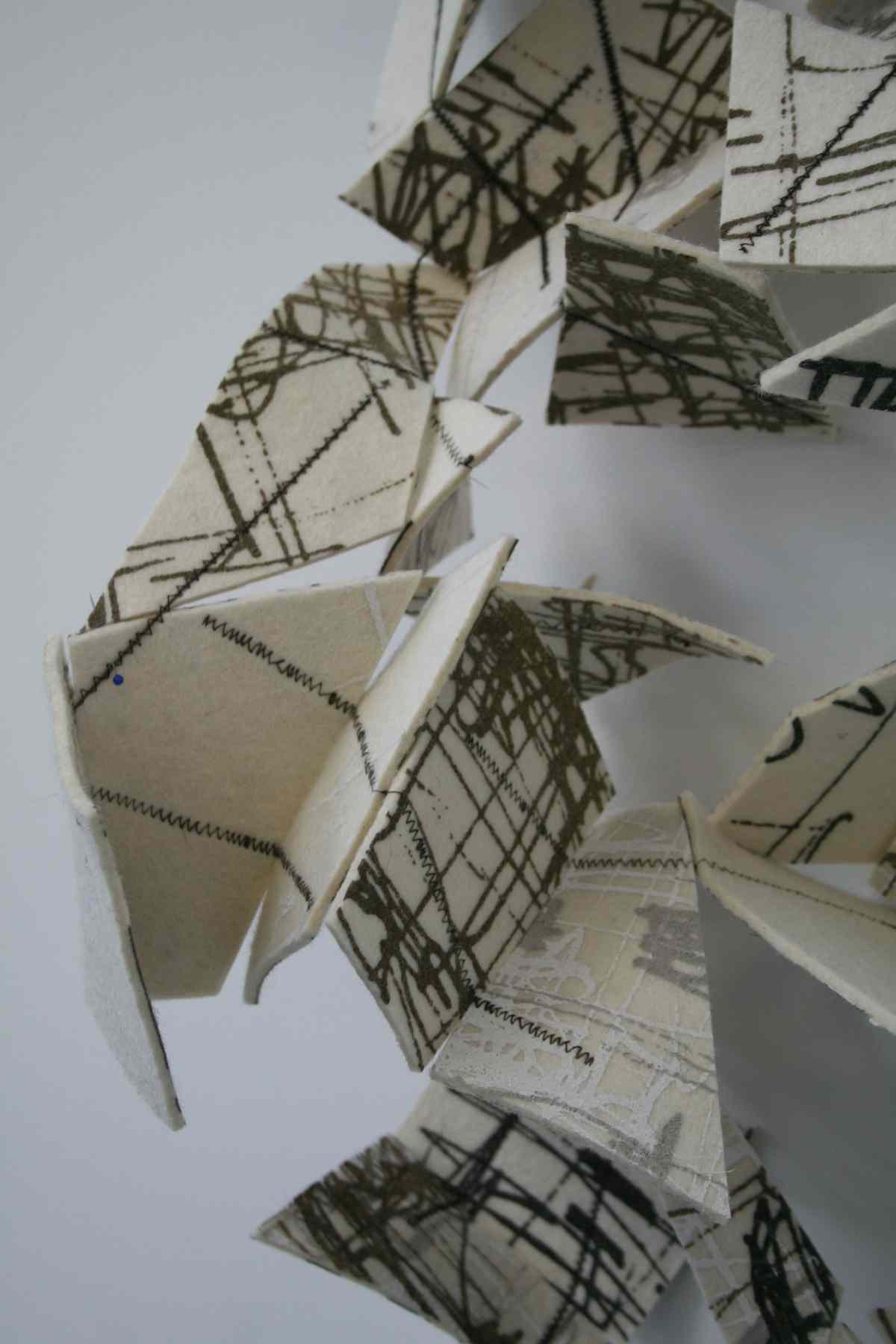 Investigating book structures in preparation for my finished item I visited structures that had been completed over the years before embarking on new samples specific to Module 4. Hope this is acceptable! Ref 4.10.1 shows a shape I made for Module 1
Investigating book structures in preparation for my finished item I visited structures that had been completed over the years before embarking on new samples specific to Module 4. Hope this is acceptable! Ref 4.10.1 shows a shape I made for Module 1
Sample 4.10.2 shows Button Book made in memory of my mother and father. Using a tapestry made with my mother I made calico 'pages'. Each page contained memories that my sister and I shared of them. Linking the idea of 'pressing buttons' on different subjects i.e. music they liked, their hobbies and interests, places and journeys etc we shared together a collection of photos and memorabilia.
Over the years I have used origami books to record key memories of a year, business cards of inspiring artists, ideas from Christmas carols for making Christmas cards, diaries of a specific holiday- somehow a small piece of paper to fill a day is less intimidating than a large sheet of paper. Here are a some of the pieces:
Memories of 2010 Business card holder
' Outside In' exploration 2009,paper and fabric/board cover
Inspiration, 'In the bleak mid winter' lyrics, coloured threads, images
A month's diary at Woodbrooke
And now for some ideas not tried before:
Ref 4.10.1a and b above The stick, attached with rubber bands, was rubbed with bronze 'rub on' to match the acrylic painted and crunched magazine paper. The inside Lokta papers chosen to give a feeling of nature.
Ref 4.10.2 a and b. Using magazine paper that had been folded and glued to make a firm cover to black papers the book was held in place by cardboard letters and rubber bands.
Ref 4.10.3 a and b Magazine paper again folded and glued this book was stitched using a button hole stitch in a fan shape and thread to replicate the tree structures. In side black paper was interleaved with tracing paper in varying sizes.
Ref 4.10.4. Using an offcut of coloured newspapers from an earlier module this booklet used tissue paper to make the inside papers with a normal running stitch used on one seam and a knotted stitch used on the other seam to add interest.
Ref 4.10.5 a and b. A black and white theme inspired by this cartoon simplicity seemed the key with just a three hole joining stitch to alternative black and white pages.
Intrigued by the theme of this module I had decide to take a break to Burnbrae, Nr Kelso to sign up for a course with Mary Sleigh. The book cover seen in sample 4.10.6 a and b and the final samples shown in 4.10.8 are the pieces made during a truly inspiring two days. The book leaves shown in 4.10.6a and 4.10.7a, b and c were made on returning home and while they are not to be used in the book cover shown they were a trial run at how I would approach completing the project.
Ref 4.10.6a cover and papers Ref 4.10.6b inside book cover
Ref 4.10.7a, marking up to ensure holes were in correct position through all pages
Ref 4.10.7b and 4.10.7c ribbon looping with rayon perle - not the best thread to use as very slippy but colour was right and it was a very old thread that I had had for years!
And last but not least a book dedicated to the inspiration of Gudrun and Mary completed at Burnbrae.
 As well as going through my sketchbook I enjoyed going through pieces rejected from previous chapters to see if they make a last call on my imagination. The picture,right of a grid pattern found as a path on Hadrian's Wall had a certain resonance to how my thoughts were progressing. I also looked at my pinboard to see if something was lurking behind the plethora of notes and reminders - it helps me clear my workspace which by chapter 11 is somewhat overcrowded! So here are the evolving thoughts for the final sample.
As well as going through my sketchbook I enjoyed going through pieces rejected from previous chapters to see if they make a last call on my imagination. The picture,right of a grid pattern found as a path on Hadrian's Wall had a certain resonance to how my thoughts were progressing. I also looked at my pinboard to see if something was lurking behind the plethora of notes and reminders - it helps me clear my workspace which by chapter 11 is somewhat overcrowded! So here are the evolving thoughts for the final sample.  As well as going through my sketchbook I enjoyed going through pieces rejected from previous chapters to see if they make a last call on my imagination. The picture,right of a grid pattern found as a path on Hadrian's Wall had a certain resonance to how my thoughts were progressing. I also looked at my pinboard to see if something was lurking behind the plethora of notes and reminders - it helps me clear my workspace which by chapter 11 is somewhat overcrowded! So here are the evolving thoughts for the final sample.
As well as going through my sketchbook I enjoyed going through pieces rejected from previous chapters to see if they make a last call on my imagination. The picture,right of a grid pattern found as a path on Hadrian's Wall had a certain resonance to how my thoughts were progressing. I also looked at my pinboard to see if something was lurking behind the plethora of notes and reminders - it helps me clear my workspace which by chapter 11 is somewhat overcrowded! So here are the evolving thoughts for the final sample. 






















































